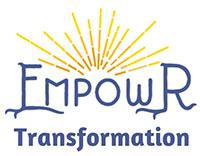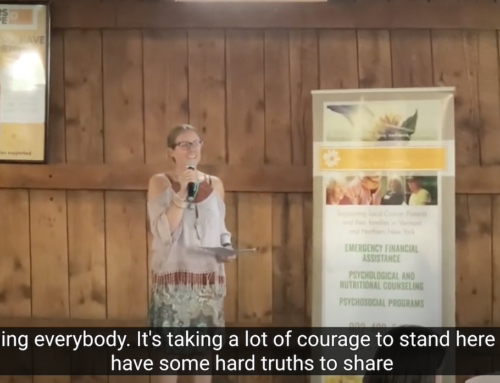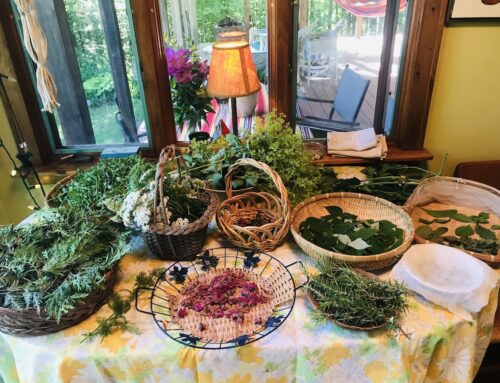“Let go of what no longer serves you.” Before I received a breast cancer diagnosis in early 2018 at age 41, I had been trying to figure out what this means for me. As I now understand cancer to be interconnected with energy trapped in vulnerable parts of your body, wreaking havoc and leading to dis-ease, I clearly had not succeeded at “letting go.”
As a woman with a passionate voice who feels deeply, I’ve heard the phrases “you’ve got to let it go” and “tone it down” on many occasion over the years leading up to the cancer diagnosis. Often connected to those who held positions of power over me trying to silence my voice, just hearing the words “let it go” became a trigger.
The breast cancer diagnosis came at a time when my sense of agency over my life had been diminished to such an extent that I could actually feel the trapped energy in my body, which led me to feel like I couldn’t breathe. I was tremendously unhappy and in a way, believed the breast cancer diagnosis was the catalyst for change I had energetically been calling in.
The Build Up of Tension
As it is for many people in my generation – the forgotten Generation Xers — the American dream failed. My privilege afforded my being able to attend college where I majored in “something practical” so I could make a living, rather than following any of my dreams. I believed my dreams could wait because, as advised by numerous Baby Boomers, if I worked hard early in my career, I would be successful later in life. As a member of the first generation to not be better off than their parents, I struggled with watching capitalism fail, because I didn’t know how to attempt success any other way. I felt blindsided which left me in a deep depression, contributing fervently to the trapped energies of anger, sadness, blame, and envy in my body.
So what was I to let go of? A dream? Patriotism? Negativity? Anger? Frustration? Ego? But how? The downward cycle kept spinning and then I learned I had cancer. Temper tantrums and nervous breakdowns became common and ironically it was the physical release of screaming and crying, without being told to tone it down, that inspired a quest to learn how to let go.
I began to understand in order to let in healing, I needed to create space, and in order to create space, I needed to let go. Supported generously by a Go Fund Me to to pay for medical costs not covered by insurance, holistic healing modalities, and the time I needed to heal, I embarked on a cancer healing journey. Reading, journaling, acupuncture, reiki, shamanic journeying, restorative and yin yoga, myofascial release, lymphatic massage, cranial sacral therapy, mindfulness practice, astrology, and feminist spirituality all played critical roles in helping me heal and find wholeness with who I am today.
I was determined to uncover how to let it go, and realized what I learned is relevant to many people who are suffering – whether it’s due to a long term illness or other causes of pain and suffering in life.
Ten Steps to Let Go
- Breathe. I needed to just be with myself, my feet grounded firmly beneath me without being anywhere near a mobile device, and not walking or eating or writing. I needed to Not.Do.Anything but sit or stand. I began to breathe from deep within my belly and let the exhale all the way out, over and over and over.
- Feeling. While I sat doing nothing but breathing, I felt feelings and sensations in and on my body. I tasted and smelled, and listened to sounds and named each one individually. I looked — at trees, at bugs, at my hands, at my dog — anything around me I just noticed. I began to understand how harmful bottling up feelings is for our health. I began to make the connection between the social expectations of hiding our feelings and the overwhelming number of health issues from which people suffer. I began to understand that in order to heal, I needed to feel everything I was feeling, even if that was discouraged in my support system. I learned all feelings are valid.
- Intentions. How did I want to feel? I wanted to feel free. I wanted to feel loved, supported, healthy, safe, respected, and able to express myself. It was incredibly hard to imagine how I could feel any of those feelings in the midst of such agony, but I began integrating these words into self talk and writing. I learned I needed to shift my decision making process to a more feminine approach centered on how I desire to feel, rather than being attached to a goal. I stopped putting energy into people, activities, and behaviors that didn’t help me feel the intentions I identified for myself.
- Release of Belongings. I went through the entire house and got rid of so much stuff — cleared out the hidden corners, emptied the past, and created the space for something new. We held a garage sale which was a really positive day a clearing and making some cash. My partner and I sat in the garage for two days just being together and talking about the stuff we were letting go of — why we don’t use it, what it represented, how it made us feel at the time in our life when we used it, and the lesson that time of life may have taught.
- Release of Physical Tension. I learned how to cry with my whole body — shudder, wail, spit, cough, scream, stomp — getting it out! Now that I was more in tune with where feelings and tension sat in my body, I was able to focus on releasing the pressure. Yoga, massage, and myofascial release combined with visualization and breath work helped release tension and began to heal the torn fascia from multiple surgeries and tight muscles from years of stress.
- Love. Shifting from thinking about cancer as a fight to loving my body was an extremely positive perspective change for me. A fight is something many people can lose, but LOVE ALWAYS WINS. I offered compassion and healing light to the areas of my body in pain. I focused on balancing my chakra energy centers and learned more about human anatomy so I could visualize where I was sending light. Instead of being frustrated with the pain, I sent it love and imagined clearing blocked energy to increase my own flow of life-force.
- Gratitude. Learning how to be grateful truly accelerated my healing, even though it took a while to figure out. How can you be grateful when so much is wrong? When I realized the truth around the law of attraction and how negativity attracts negativity, I started to discover parts of why my life had fallen so deeply apart. My partner and I began a gratitude practice that we continue to use everyday. Each morning we ground our feel evenly to the surface below and express what we are grateful for out loud. When we reach a stressful point in the day or week, we hold each other accountable to refrain from complaining, and instead share what we are grateful for that happened that day or week, and what lessons we learned from the challenges.
- Mindfulness. Being mindful is also a daily practice I learned by becoming more self aware, listening to guided meditations on You Tube, and stopping judgments of myself or other people. Once I was able to practice mindfulness and could stay focused and aware of the present moment, without creating a story in my mind, a dramatic shift in my health began to transpire. I started to understand healing is the act of becoming whole in a new way because you never go back to who you were after cancer or other long term illness, dis-ease, or trauma. While I ended up losing my right breast, I feel more whole than I ever was before cancer.
- Expectations. While it’s important for me to have autonomy over the decisions I make, as that’s a critical part of being empowered, accepting that I do not have any control over other people was something I had to overcome. This was also hard because of other people’s expectations of what I “should” do, say, or act. I decided to remove the word “should” from my vocabulary. I stopped planning and starting being. I have a vision for my life moving forward, but I cannot be attached to the outcome. Instead I stay true to my intentions and do, say, and act based on how I want to feel. It takes work every single day and I can lose my grounding. However, instead of judging myself for not releasing expectations, I look at every experience as a learning opportunity and am grateful for the lesson.
- Saying Goodbye. More often than not, letting go leads to releasing people from life who no longer serve you. For me it was family, friends, and colleagues. This loss has been incredibly painful — much worse than losing my breast, and it still hurts. The connectivity between self worth and losing people while trying to believe in yourself and not directing energy towards blame is incredibly challenging. It comes back to love and boundaries, and prioritizing myself, my health, and my energy. When I am sad about all of the loss, I shift my perspective to gratitude for all I have found.
Acceptance
As I discovered each of these lessons, I came to realize the true meaning of letting go is acceptance. Acceptance of people and situations for who and what they are, which includes accepting what has happened to me. In order to truly let go, to truly accept, there must be forgiveness. I had to forgive all of the people who hurt and betrayed me. I had to forgive all of the people who tried to take away my power and my voice. And I had to forgive myself, for giving away my power, for decisions I made, ways I behaved, things I said, and then I let it all go.
The old narrative is over. The world is changing. And I am worthy of loving myself, of being loved, of living a life that feels good for me, and of being the person I am meant to be.
I offer what I learned so you may find hope, inspiration, and wisdom to help support your own path to wholeness in mind, body, soul, and spirit.
Learn more about working with Rae with EmpowR healing sessions.
This article was originally published in The World Newspaper and was reprinted for the UVM Medical Center Blog.
Please consider becoming an EmpowR Patreon to join our community of co-creating change!



